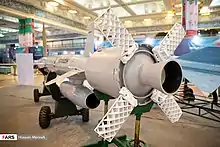Hoveyzeh (cruise missile)
The Hoveyzeh (Persian: موشک کروز هویزه) is an Iranian designed and built, all-weather, surface-to-surface cruise missile.[1][2][3] The Hoveyzeh is from the Soumar family of cruise missiles.[1][4] The missile was unveiled at a defense exhibition in Tehran on 2 February 2019 during celebrations of the 40th anniversary of the 1979 Iranian Revolution.[1][2] The Aerospace force of the Islamic Revolutionary Guard Corps will acquire and be supplied with these missiles.[3]
| Hoveyzeh cruise missile | |
|---|---|
 | |
| Type | Cruise missile |
| Service history | |
| In service | 2019 – present |
| Used by | Iran |
| Specifications | |
| Propellant | Turbo-jet engine |
Operational range | 1350 km (839 Miles) |
| Flight altitude | Sea-skimming |
Guidance system | Inertial navigation system |
| Accuracy | 1m |
Launch platform | Multiple Launch Rocket System |
The surface-to-surface cruise missile is capable of low altitude flight and has a range of 1350 km, a maximum range has not yet been given,[5] with the ability to strike ground targets with high precision and accuracy.[1][4][6] Discussing the capabilities of the missile, the Israeli website DEBKAfile states that there is: "...no military force in the world has so far found an effective means of intercepting cruise missiles before they strike, unless they are short range."[6]
Name
The Hoveyzeh surface-to-surface cruise missile is named in honor of the Iranian town of Hoveyzeh in the Khuzestan Province.[1] The city sustained heavy casualties and ubiquitous damage during the war and was a victim of chemical weapons used by Iraqi forces during the Iran-Iraq War.[1][3][4]
Development
The Hoveyzeh is a part of the Soumar cruise missile family, which was unveiled in 2015 with the first missile of the family being the Soumar which had a range of 700 km.[4] Although this claim is disputed by some media outlets claiming that due to the missile's similarities with the Kh-55, acquired from Ukraine in 2001, that the Soumar missile has a range of 2000–3000 km.[7] It is believed that the Hoveizeh is either an upgrade to or has been developed from the Soumar.
It was unveiled and displayed to the public on 2 February 2019 at a Tehran defense exhibition celebrating the 40th anniversary of the 1979 Iranian Revolution.[1][2] The missile was put into service and will be supplied to the Aerospace force of the Islamic Revolutionary Guard Corps.[3]
During Iranian Defense Minister Brigadier General Amir Hatami's interview with the press about the missile, he stated that the missile has been designed and manufactured by Iran Aviation Industries Organization (IAIO) with the missile being tested on the day of the unveiling, complemented with video evidence, successfully travelling 1,200 km and striking test targets with precision accuracy.[1][2][3][5][6]
Defense Minister Brigadier General Amir Hatami also stated during his address that its motor utilizes a turbofan, that it releases low heat signatures and that the missile is equipped to deal with the most sophisticated types of electronic warfare.[1]
Capabilities

The missile is capable of low altitude flight[1] with a range of 1350 km,[1] although a maximum range has not yet been given.[5]
Israeli military intelligence website DEBKAfile states that: "Iran has succeeded in producing low-flying cruise missiles that fly to target under the radar."[6] Which allows the cruise missile to "...hug mountains and hills and dip into valleys, thereby evading the radars of counter-missile systems."[6] DEBKAfile further elaborates the significance of the cruise missile's design stating that "... no military force in the world has so far found an effective means of intercepting cruise missiles before they strike, unless they are of short range."[6]
The missile is capable of low altitude flight and thus has the ability to fly under ground-based radar systems of all missile defense systems.[6] Air-borne radar systems like the AWACS can detect cruise missiles within a relatively constrained area. This is usually done during active military engagements due to cost and limited numbers of planes. Additionally any system capable of detecting the launching or take off of aircraft (Eg surveillance satellites) can be used to identify that a cruise missile has been launched, which can give a responding military force time to get effective airborne surveillance aloft.
The best active defense against cruise missiles can be found in a modern aircraft carrier battle groups because they use an overlapping combination of ship-based and airborne surveillance designed specifically to prevent low-altitude attacks like cruise-missiles (and water-based low-speed attacks Eg the motorboat used against the USS Cole). There are a limited number of systems capable of this method of defense and they are very expensive to build and to maintain actively. Until airborne detection systems can be kept aloft cheaply and permanently cruise missiles will remain a significant threat to anyone who cannot afford the systems required to defend against them. [6]
Operators
 Iran- Number of units is unknown
Iran- Number of units is unknown
See also
References
- "Press TV article titled: "Iran unveils long-range Hoveyzeh cruise missile"". Press TV. 2 February 2019. Retrieved 27 May 2019.
- Staff, Toi (2 February 2019). "Times of Israel article titled: "Iran says new cruise missile successfully fired on revolution's 40th anniversary"". Times of Israel. Retrieved 27 May 2019.
- "Iran unveils long-range Hoveyzeh cruise missile". Tehran Times. 2 February 2019. Retrieved 27 May 2019.
- Scarsi, Alice (3 February 2019). "World War 3: Furious Iran taunts US with new cruise missile vowing to 'respond to threats'". Express UK. Retrieved 27 May 2019.
- "Iran unveils, successfully tests new long-range cruise missile (VIDEO)". RT (Russia Today). 2 February 2019. Retrieved 27 May 2019.
- Shalem, Diane (2 February 2019). "Neither Israel nor US has the capacity to counter Iran's new cruise missile". DEBKAfile. Retrieved 27 May 2019.
- https://www.janes.com/article/49935/iran-reveals-new-soumar-ground-launched-cruise-missile Janes Defense. 2015-03-12. Retrieved 27 May 2019
External links
Videos
- https://www.youtube.com/watch?v=ELiD4tM2E4E- Euronews (English)
- https://www.youtube.com/watch?v=jJIXPdi-ZLQ- Ruptly (Farsi, not translated to English)
- https://www.youtube.com/watch?v=gmSst1TuT34- IRIB (Iranian-state TV, Farsi)